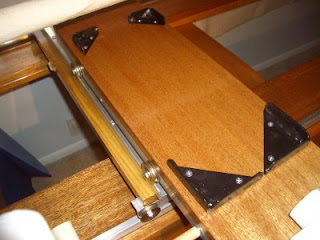


















Ok, I had a great time learning to make the smaller lap quilts, but I want to make the bed-size quilts. Hand stitching that size Hawaiian quilt can take up to two years, working on it full-time. I don’t have that kind of patience or attention span. The next step is to learn to machine quilt.
Devan’s Scrappy Diamonds quilt has created another problem. My sewing table is only 2 feet by 4 feet. The thought of wrestling with 3 layers on quilt on that small space was more than I could face. So…to the internet.
Cheapskate that I am, I looked for a portable machine quilt frame that was fairly economical. Ones that I like were the Handiquilter II, B-Line, and especially the New English Quilter. I found there is no such thing as an economical frame. The price might be right, but shipping to Hawaii can cost nearly as much as the frame.
So my next thought was if I could find the plans or blueprints, my husband, handy guy that he is, needed a new project and could build one for me. Easier said than done, however. One comment I found on the internet that was so true was something like: “A person could find instructions to build a bomb, but machine quilt frame plans are nearly impossible to find.”
After several months of searching and revising my “requirements,” I found plans that would serve my purpose and were reasonably priced. I first found these plans on eBay and then went to his website. After several days of contemplating, I bought the plans, printed them out, and handed them to my husband. He was off to the hardware store like a shot.
Ok, I had a great time learning to make the smaller lap quilts, but I want to make the bed-size quilts. Hand stitching that size Hawaiian quilt can take up to two years, working on it full-time. I don’t have that kind of patience or attention span. The next step is to learn to machine quilt.
Devan’s Scrappy Diamonds quilt has created another problem. My sewing table is only 2 feet by 4 feet. The thought of wrestling with 3 layers on quilt on that small space was more than I could face. So…to the internet.
Cheapskate that I am, I looked for a portable machine quilt frame that was fairly economical. Ones that I like were the Handiquilter II, B-Line, and especially the New English Quilter. I found there is no such thing as an economical frame. The price might be right, but shipping to Hawaii can cost nearly as much as the frame.
So my next thought was if I could find the plans or blueprints, my husband, handy guy that he is, needed a new project and could build one for me. Easier said than done, however. One comment I found on the internet that was so true was something like: “A person could find instructions to build a bomb, but machine quilt frame plans are nearly impossible to find.”
After several months of searching and revising my “requirements,” I found plans that would serve my purpose and were reasonably priced. I first found these plans on eBay and then went to his website. After several days of contemplating, I bought the plans, printed them out, and handed them to my husband. He was off to the hardware store like a shot.

















